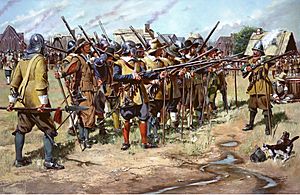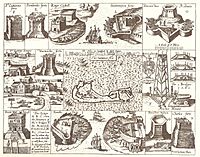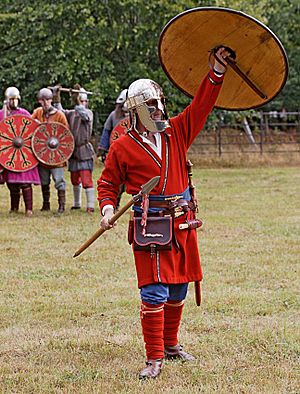Militia (England) facts for kids

The English Militia was like a backup army for the Kingdom of England. These groups of citizen-soldiers were formed in England for a long time. They helped keep the country safe and defended against attacks. One of the first groups was called the fyrd. These were free men who protected their local area or joined bigger armies.
Over the years, the English Militia fought in many wars. This included the Wars of Scottish Independence and the Hundred Years' War. They also played a big part in the Wars of the Three Kingdoms. After England and Scotland joined together in 1707, the English Militia became part of the British Militia.
Contents
How the Militia Began
The idea of people having to serve in the army started very early in England. Even before England was a single country, people had to join the fyrd. This was part of their duty as citizens. Records show this rule existed in different kingdoms by the 7th and 8th centuries.
By the 10th century, areas were divided into 'hundreds' for the fyrd. Landowners had to serve, usually for about 60 days.
After the Norman conquest of England in 1066, a new system called feudalism arrived. This also involved military service. But the old fyrd system still continued. In 1181, a law called the Assize of Arms of 1181 combined these ideas. It said that all free people had to own certain weapons based on their wealth.
Later, in 1285, the Statute of Winchester made it a rule for all able-bodied men aged 15 to 60 to be ready for military duty. This included everyone, even those who were not free.
Militia in the 1500s
In 1511, King Henry VIII made it clear that all citizens had a duty to serve. He ordered officials to make sure men were ready and had the right equipment. This helped create a more organized system for raising armies.
By the late 1500s, England had a large number of men ready to serve in the militia. In 1575, about 183,000 militiamen were counted. In 1588, over 132,000 were expected to fight if Spain invaded. However, many of these men were not well-trained. Their weapons, like longbows, were also becoming old-fashioned.
This led to the creation of the more skilled Trained Bands. These were better-trained and better-equipped soldiers. By 1588, about 50,000 men were in the Trained Bands. They used more firearms, pikes, and fewer longbows.
A new law in 1558, the Militia Act, made the system even more organized. It created a single national militia system. However, this act was later removed in 1604. This caused the militia to become less organized for a while.
English Civil War and New Armies

The start of the English Civil War was a fight between King Charles I and Parliament. Both wanted control of the militia. The first big battle, the Battle of Edgehill in 1642, showed that both sides had armies that were not very good. They were poorly trained and led.
While the King's side kept using amateur soldiers, Parliament created the New Model Army. This was a smaller, but very disciplined and well-trained army. Its officers were chosen for their skills, not their family name. The New Model Army defeated the King's army in 1645. This ended the first part of the war.
After King Charles I was executed, the New Model Army became very powerful. But people worried about having a strong standing army. When King Charles II returned to the throne in 1660, the New Model Army was disbanded. However, a small standing army was still needed to protect the King and guard important places. So, a new army was created.
New laws in the 1660s put the militia under the control of local leaders. This made the militia a way to balance the power of the standing army. It also helped keep order and protect people's rights.
Militia and the Army's Role
By 1685, the army was still seen as the King's personal guards. It was not officially a part of the government by law. Everyone still expected the militia to be the main fighting force if there was a war. However, the army proved to be faster and more effective. It defeated the Monmouth Rebellion in 1685, while the militia was too slow to get ready.
After this, King James II expanded the army. The Glorious Revolution in 1688 brought King William III to the throne. He had interests in Europe, which led to the army becoming a major military power. By 1704, the army was an accepted part of the state. Laws like the Bill of Rights in 1689 made sure Parliament controlled the army.
The militia, however, became less important. It was often poorly trained and sometimes not even called up for years. By 1745, it was easier to raise new volunteer forces than to rely on the old militia.
Militia in the English Empire

When England started settling in North America in 1607, regular soldiers could not always help. Settlers had to deal with attacks from other countries and native groups. So, they immediately formed their own militias. The militia in Jamestown often fought against the Powhatan Federation.
In Bermuda, another English outpost, building defenses was very important. In 1614, a Spanish attack was stopped by two shots from the unfinished Castle Islands Fortifications. These forts were manned by Bermudian Militiamen. For a long time, Bermuda's defense was entirely up to its militia. All male civilians had to train and serve. The Bermudian militia also had trained artillerymen to guard the many forts. These artillerymen were volunteers or even criminals serving as punishment.
The Bermudian militiamen were called out many times during wars. They even helped drive out Spanish and French forces from the Turks Islands in 1710. By this time, the Acts of Union had made all English militiamen "British."
Political Ideas About the Militia
Before the Glorious Revolution in 1688, the King and Parliament often disagreed. The English Civil War left a lasting impact on how people viewed the military. Both the Whigs and Tories worried about having a large standing army. They feared it could be used by a king to become a dictator. They also remembered the New Model Army and the big changes it brought.
Because of these worries, both groups preferred a small standing army. This army would be controlled by civilians. It would be used for defense and foreign wars. They also wanted a strong navy to protect the country. And they wanted a militia made up of local people. This militia would provide extra defense and keep order at home.
The English Bill of Rights (1689) stated that a standing army in peacetime was against the law. This was unless Parliament agreed to it. It also said that Protestants could have weapons for their defense. This meant they could serve in the militia. The militia was meant to balance the power of the standing army. It would protect people's freedoms against a powerful king or government.
Today, the King or Queen still officially controls the army. This means soldiers promise loyalty to a neutral head of state, not a politician. Parliament controls the army's money each year. It also renews a law called the Mutiny Act every year. If this law isn't renewed, soldiers lose their legal protection for actions taken under orders.
The 1700s and the Union
In 1707, the Acts of Union joined the Kingdom of England and the Kingdom of Scotland. The Scottish navy joined the Royal Navy. The Scottish army joined the English army, forming the new British Army. However, the militia in England and Wales continued to be separate from the militia in Scotland. Later, after 1801, they would all become part of the Militia of the United Kingdom.


